History
A shrine was
built near here in 1408 to house a painting of the Virgin commissioned by
Francesco Amadi, on the walls of whose house it hung.
This image soon got a reputation for working miracles and donations allowed for the building of a
small wooden church squeezed into the same campo. Work began in 1481 on
the present church and
continued into the early 1490s, with consecration on 31st December 1489. The church was
designed by Pietro Lombardo and embellished with carvings by him, his
sons, and their workshop.
The initial work, under Pietro's direction, resulted in the construction
of the barrel-vaulted nave, and in 1485 it was decided to add the raised
presbytery, surmounted by a dome designed by him. It was funded by Angelo Amadi, the nephew of Francesco who had had the icon painted. The
uncle had also been married to noted beauty Elena Badoer.
A year into the building work it was decided to remove the church from
parish control and make it part of a monastic institution, so the Amadi family
house nearby was given to the Franciscan Order of Poor Clares and the
first twelve nuns came from the
convent of
Santa Chiara on Murano. The ceiling
seems to have been a 16th-century replacement of the original, and
although the church seems to have remained untouched
since then the 16th, 17th and 18th centuries saw the creation, and
movement around the place, of many paintings and altars for this church
(see Lost art below).

All were removed
when the church and its high altar were returned to their supposed
original state in the late 19th century, with their places taken by marble
panels. The appearance of the church before this work can be judged from
the 1840 print (see above). This work has been characterised as
turning a devotional shrine into a monument. The replacement of the marble
facings began in 1865 under the Austrians but work stuttered after the
unification, only resuming in 1883 after several visits by the King to the
church, who found pigeons and sparrows flying in and out of the broken
windows. The work was completed by 1887
The exterior, and
marbles list
The arms of the Amadi family are to be seen over the door.
The handsome marble-clad exterior - unusually you can admire all four
sides of this church - was the first church since San Marco to be so completely covered.
It's also probably the earliest example of superimposed orders of
pilasters (different on the lower and upper levels) in Venice. The
large semi-circular gable echoes the barrel-vault inside.
The Virgin and Child over the door is by
Giorgio Lascaris, but he signed it with the name Pyrgotoles, a famed
carver from antiquity mentioned by Pliny the Elder as one favoured by
Alexander the Great, none of whose work is known to survive.
The marbles and stones used on the exterior are Pavonazzo (white
with black and grey veining), Broccatello Rosso (pale red),
Verona marble (deep red), Porphyry (purple), Verd Antique (dull, dark
green), Alabastro a Pecorella (little sheep alabaster) (red) and
Serpentine (dark green).
Interior
Much rhapsodising and plenty of purple prose have been devoted to
this interior, using phrases like 'Renaissance jewel box', but you'll
forgive and forget when you get inside and sit and wonder. The space consists of a
single nave, a decorated wooden barrel vault and a chancel up a steep
flight of steps, raised so that everyone can see the venerated image of the
Virgin. There is a domed apse above and the sacristy is underneath the
chancel. There are no columns to complicate the space, and no great paintings remain.
It's not the details that appeal, it's simply the perfectly-proportioned
whole, as you are enclosed by the polychrome marble
patterns and porphyry and admire the fine carving skills of the Lombardi.
It's very reminiscent of
San Miniato in Florence, but so much smaller.
The marble facing of the upper half of the nave walls is thanks to the
19th century 'restoration' work, though, as this area was originally
stuccoed.
The
railings of the staircase up to the chancel have small statues of The Virgin and the Angel of the Annunciation
(see right), and
Saints Francis and Clare, all by Pietro's son Tulio Lombardo.
The
miracle-working painting of The Virgin and Child by Niccolo di
Pietro is
above the altar. On either side of the altar are bronze
statues of Saint Peter and Saint Anthony Abbot. They are by Vittoria, who was a
pupil of the Lombardi, and are the only later additions to their work.
The ceiling
features fifty square panels depicting mostly Old Testament prophets,
patriarchs, kings and others. The pendentives are Sibyls (east
side) and Old Testament Heroines (west side). They are all by Pier
Maria Pennacchi and his assistants, and date to just before 1515, the year of Pennacchi's death.
The paintings on the underside
of the barco (nun's gallery) at the back are attributed to Marco Vecellio, Titian's nephew, and
dated to the 1580s or 90s. The main subjects are The Virgin and Child,
Saint Francis and Saint Clare, the last two reflecting the
order occupying the convent.
The convent and
cavalcavia
The convent was also the work of the Lombardi.
It was suppressed on 25th April 1810 and by 1813 had been handed over to
the Municipality for use as, you guessed it, a barracks. It later passed
into private hands.
Until the
19th century a nuns' passageway (the cavalcavia - seen in the two old
prints below) linked the nun's
gallery (barco) in the church to the convent. It was less a
footbridge as it contained two rooms with benches, cupboards and
paintings, but it was destroyed in 1810. The barco contained around
twenty-six paintings at this time and the chapter house and refectory
housed another twenty-one.
Ruskin wrote
The most interesting and finished example in Venice of the
Byzantine Renaissance, and one of the most important in Italy of the
cinque-cento style. All its sculptures should be examined with great care,
as the best possible examples of a bad style. Observe, for instance, that
in spite of the beautiful work on the square pillars which support the
gallery at the west end, they have no more architectural effect than two
wooden posts. The same kind of failure in boldness of purpose exists
throughout; and the building is, in fact, rather a small museum of
unmeaning, though refined sculpture, than a piece of architecture.
Its grotesques are admirable examples of the base Raphaelesque design
examined above. Note especially the children's heads tied up by the hair,
in the lateral sculptures at the top of the altar steps. A rude workman,
who could hardly have carved the head at all, might have been allowed this
or any other mode of expressing discontent with his own doings: but the
man who could carve a child's head so perfectly must have been wanting in
all human feeling, to cut it off, and tie it by the hair to a vine leaf.
Observe, in the Ducal Palace, though far ruder in skill, the heads always
emerge from the leaves, they are never tied to them.
Lost art
A Giovanni Bellini triptych depicting Saint Jerome
in the Desert is mentioned by Sansovino as on the left hand
side of the nave here
in 1581.
Boschini in 1664 mentions panels of Saint Francis and Saint
Clare, also by Bellini, flanking the Saint Jerome. All three
are lost.
A two-panel Annunciation by Giovanni Bellini and his studio
(once thought to be by Carpaccio)
which once formed the outer doors of the organ here, moved to San
Francesco della Vigna in 1817, is now in the
Accademia. They purchased the Angel panel in 1907 and retrieved the Virgin
panel from storage in San Francesco della Vigna in 1910. The marble walls of the Virgin's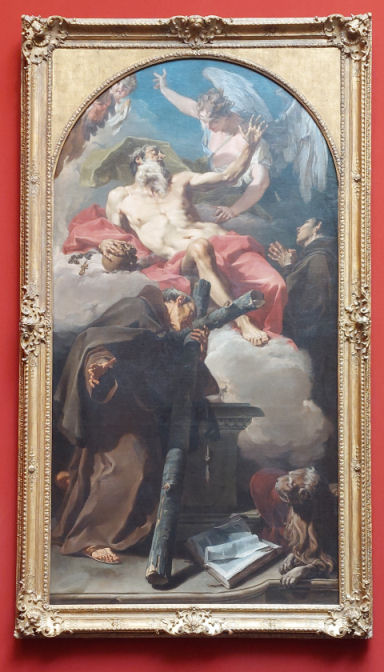 room in that painting echo the walls of the church.
The back of the panel with the unusually fluttery, for Bellini, Angel
Gabriel once
held a panel depicting Saint Peter, which is also in the Accademia. Behind the Virgin
panel, and now lost, was a Saint Paul. These works are
thought to date to just after the dedication of this church in
1489. room in that painting echo the walls of the church.
The back of the panel with the unusually fluttery, for Bellini, Angel
Gabriel once
held a panel depicting Saint Peter, which is also in the Accademia. Behind the Virgin
panel, and now lost, was a Saint Paul. These works are
thought to date to just after the dedication of this church in
1489.
Boschini also
mentions a Mary Magdalene by Titian on a movable altar here, beyond
Bellini's Saint Jerome and another Bellini of The Virgin and
Child with Saints John the Baptist, Clare and a female donor with a small
child near the door in the presbytery.
A long and narrow Dead Christ with
Two Putti (possibly a predella panel) and two full-length
panels of Saints James and Anthony Abbot, early works by by Marco Basaiti,
now in the Accademia, came from the convent here, as did a Lot and his
Wife of c.1660/70 by Johann Carl Loth.
The Apotheosis of Saint Jerome with Saint Peter
of Alcántara (see photo right) by Giovanni Battista Pittoni,
was painted c.1725 for an altar in the left-hand side of the nave here,
visible in the 1840 print (see above). It's now in the National
Gallery in Edinburgh. Some time between 1837 and 1855 it was replaced by
Sante Peranda's Martyrdom of St Sebastian.
On the other side of the nave, according to Zanetti in 1733, was
Saint Anthony of Padua Holding the Infant Christ by Giulia Lama, which
is now lost. The artist was the daughter the painter Agostino Lama and may
have trained alongside
Giambattista Piazzetta, a childhood
friend.
The church in art
The Church of Santa Maria dei Miracoli and the apse of Santa Maria
Nuova by Bernardo Bellotto (see right). Santa Maria
dei Miracole e Santa Maria Nova by Ippolito Caffi. There are two small paintings of
the rear of the Miracoli, one called A Market Scene, by James Holland in
the Lady Lever Art Gallery in Port Sunlight. He painted quite a few
versions of the same scene (similar to Bellotto's) in oil and
watercolour, one of which was owned by John Ruskin's father.
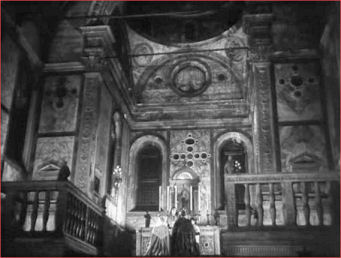
The
church in films
Orson Welles’ 1951 film version
of Othello sets the wedding of Desdemona
and Othello in this church (see right).
The flower shop in the film
Bread and Tulips in the campo behind the Miracoli
is an invention.
Donald Sutherland walks past the church in Don't
Look Now, and lets us see how grubby it was before the 1997
restoration (see below).
Opening times
Monday to Saturday: 10.30 - 5.00
A
Chorus
Church
Vaporetto Rialto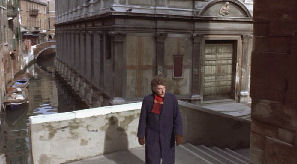
map
|
|
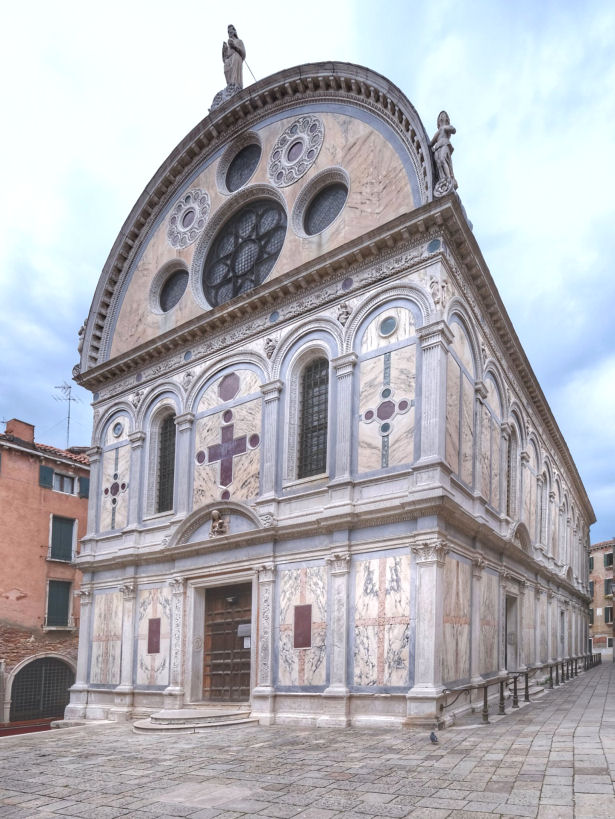

 

An engraving by Antonio Lazzari c.1830
What is going on in the foreground?!

And this one from 1703 by Luca Carlevaris has a bonfire and copulating dogs, of course.
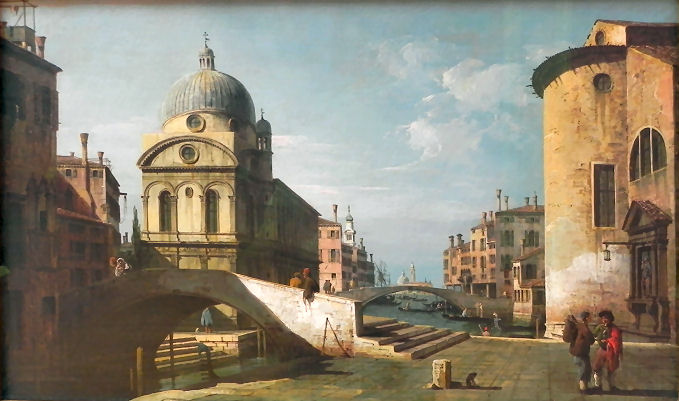
|